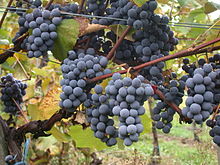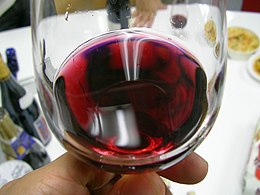Beaujolais nouveau
| Beaujolais nouveau | |
|---|---|
 | |
| Wine region | Burgundy |
| Appellation | Beaujolais |
| Varietal | Gamay |
Beaujolais nouveau (French pronunciation: [bo.ʒɔ.lɛ nu.vo]) is a red wine made from Gamay grapes produced in the Beaujolais region of France. It is the most popular vin de primeur, fermented for just a few weeks before being released for sale on the third Thursday of November. This "Beaujolais Nouveau Day" used to see heavy marketing, with races to get the first bottles to different markets around the globe.[1] The current release practice is to ship the wine ahead of the third Thursday of November, and release it to the local markets at 12:01 a.m. local time.
History

Beaujolais had always made a vin de l'année to celebrate the end of the harvest, but until World War II it was only for local consumption. In fact, once the Beaujolais AOC was established in 1937, AOC rules meant that Beaujolais wine could only be officially sold after 15 December in the year of harvest.[2] These rules were relaxed on 13 November 1951,[2] and the Union Interprofessionnelle des Vins du Beaujolais (UIVB) formally set 15 November as the release date for what would henceforth be known as Beaujolais nouveau.
A few members of the UIVB saw the potential for marketing Beaujolais nouveau. Not only was it a way to clear lots of vin ordinaire at a good profit, but selling wine within weeks of the harvest was great for cash flow. Hence the idea was born of a race to Paris carrying the first bottles of the new vintage. This attracted a lot of media coverage, and by the 1970s had become a national event. The races spread to neighbouring countries in Europe in the 1980s, followed by North America, and in the 1990s to Asia.[2] In 1985, the date was changed to the third Thursday in November to take best advantage of marketing in the following weekend.
Production

Beaujolais nouveau is made from the Gamay noir à Jus blanc grape, better known simply as Gamay. The grapes must come from the Beaujolais AOC, with those of the ten "cru" appellations excluded. They are grown in "stony, schistous soils".[3] Both Beaujolais Nouveau and Beaujolais-Villages Nouveau are produced; the latter comes from the ~ 30 non-cru villages in the region.
By law, all grapes in the region must be harvested by hand. The wine is made using carbonic maceration,[3] whole berry anaerobic fermentation which emphasizes fruit flavors without extracting bitter tannins from the grape skins. Grapes are loaded into a large (on the order of 20,000-U.S.-gallon (76,000 L)) sealed container that is filled with carbon dioxide. Grapes that are gently crushed at the bottom of the container by the weight of the grapes start to ferment, emitting more CO2. All this carbon dioxide causes fermentation to take place inside the uncrushed grapes (without access to oxygen, hence "anaerobic fermentation"). The resulting wine is fresh, fruity, and very low in tannins.
Celebration

This "Beaujolais Day" is accompanied by publicity events and heavy advertising. The traditional slogan, even in English-speaking countries, was "Le Beaujolais nouveau est arrivé!" (literally, "The new Beaujolais has arrived!"), but in 2005 this was changed to "It's Beaujolais Nouveau Time!". In the United States, it is promoted as a drink for Thanksgiving, which always falls exactly one week after the wine is released (on the fourth Thursday of November). Many producers release the nouveau with colourful or abstract design that changes every year, usually as an evolution from the previous year's design. Duboeuf has silk ties made each year with their label's abstract design, and releases them through select wholesalers and distributors.
Style

Beaujolais nouveau is a purple-pink wine reflecting its youth, bottled only 6–8 weeks after harvest. The method of production means that there is very little tannin, and the wine can be dominated by such fruity ester flavours as banana, grape, strawberry, fig and pear drop. The wine is recommended to be slightly chilled to 13 °C (55 °F).
Beaujolais nouveau is intended for immediate drinking. While some nouveau can be kept for a few years, there's no real reason to, as it doesn't improve with age. For comparison, standard Beaujolais AOC wines are released the following year and can be stored for one or more years before consuming. The wines show definite variation between vintages, and as such are considered to be an early indicator of the quality of the year's regional wine harvest.
For a period around the late 90s some wine critics criticized Beaujolais nouveau as simple or immature. For example, the prominent wine critic Karen MacNeil wrote that "Drinking it gives you the same kind of silly pleasure as eating cookie dough."[4] Another well-known wine critic Robert M. Parker, Jr. disagrees, calling those opinions "ludicrous" and describing the better vintages as "delicious, zesty, exuberant, fresh, vibrantly fruity" wines.[3]
Similar wines
The commercial success of Beaujolais nouveau led to the development of other "primeur" wines in other parts of France, such as the Gaillac AOC near Toulouse. These wines are typically released on the third Thursday of November, just like their counterparts in Beaujolais. The practice has spread to other wine producing countries such as Italy ("Vino Novello"), Spain ("vino nuevo"), and the US ("nouveau wine").
In the United States, a number of vintners have produced Nouveau-style wines, using various grapes such as Gamay, Zinfandel, Tempranillo, Pinot noir, and even Riesling.
See also
References
- ^ Parkinson, Justin (20 November 2014). "Is Beaujolais Nouveau making a comeback?". BBC News magazine.
- ^ a b c "It's Beaujolais Nouveau Time!". Union Interprofessionnelle des Vins du Beaujolais. Archived from the original (Flash) on 12 October 2007. Retrieved 14 October 2007.
{{cite web}}: Unknown parameter|deadurl=ignored (|url-status=suggested) (help) Warning - plays music by default - ^ a b c Parker, Robert M.; Rovani, Pierre-Antoine (2002). Parker's Wine Buyer's Guide. Simon & Schuster. p. 414. ISBN 9780743229319.
{{cite book}}: Cite has empty unknown parameter:|author2-=(help) - ^ Karen MacNeil, The Wine Bible Workman Publishing Company, Inc. 2001, pg. 225
External links
- 10 Fascinating Facts About Beaujolais Nouveau
- An article on Slate which explores the marketing hype associated with the wine.
